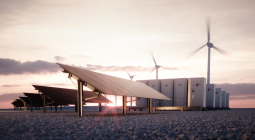Solar+Storage Helps Displace Gas On California Grid

California is using giant batteries to deploy solar energy even after sunset, boosting grid stability and evening out demand spikes while reducing its reliance on fossil fuels.
Even as gas continues to be the “backbone” of the state’s energy system, Governor Gavin Newsom announced last month that the state has just over 10 gigawatts of battery capacity, enough to meet roughly 20% of its peak electricity demand, reports Canary Media. That’s 13 times the capacity available in California five years ago.
Storage plays a “pivotal role” in California’s electric grid, replacing fossil fuels in the evening, writes the New York Times. “Between 7 PM and 10 PM on April 30, for example, batteries supplied more than one-fifth of California’s electricity and, for a few minutes, pumped out 7,046 megawatts of electricity, akin to the output from seven large nuclear reactors.”
“The future is bright for energy storage,” said Andrés Gluski, CEO of power company AES Corporation. “If you want more renewables on the grid, you need more batteries. It’s not going to work otherwise.”
Batteries help make intermittent energy sources like solar and wind more viable sources of grid electricity. After storing up electrons during periods of peak supply and lower demand, batteries distribute them back to the grid later, when they’re most needed—including after dark, or on a windless morning.
Across the United States, “power companies are increasingly using giant batteries the size of shipping containers,” the Times writes. The U.S. has increased its storage capacity 10 times over the last 10 years to around 16,000 megawatts.
In California alone, more utility-scale battery projects have been installed than anywhere in the world, except China. Ultimately, the Golden State needs an estimated 52 gigawatts of battery capacity to reach its goal of 100% clean energy by 2045. Its current plan is to triple capacity by 2035.
Not only will this help stabilize renewable energy supply, but it will also help balance the economics of energy generation. Solar energy is abundant during daylight hours, which can cause solar power stations to limit or “curtail” production because of price signals or oversupply. Installing more batteries can help reduce that curtailment and allow solar producers to maximize their energy generation, the Atlantic Council says.
Though California’s battery capacity is growing fast, it’s still not enough to avoid blackouts during heatwaves, writes the Los Angeles Times. Newsom said there is “a lot of work to do still in moving this transition.”
The industry faces other challenges as well, like the flammability of the lithium-ion batteries that many operators use, community resistance to local projects, and vulnerable supply chains.
But battery capacity across the U.S. is still expected to nearly double again this year. Much of that growth will be in Texas and Arizona in addition to California, but the driving forces differ between states. California’s battery expansion has been mostly spurred by regulation, and so far batteries appear to be reducing emissions. But market forces are driving battery deployment in Texas’ deregulated market, where developers can take advantage of the system’s wildly fluctuating electricity prices.
Profit-motivated operators sometimes charge batteries with gas or coal power, which then increases grid emissions, writes the Times





